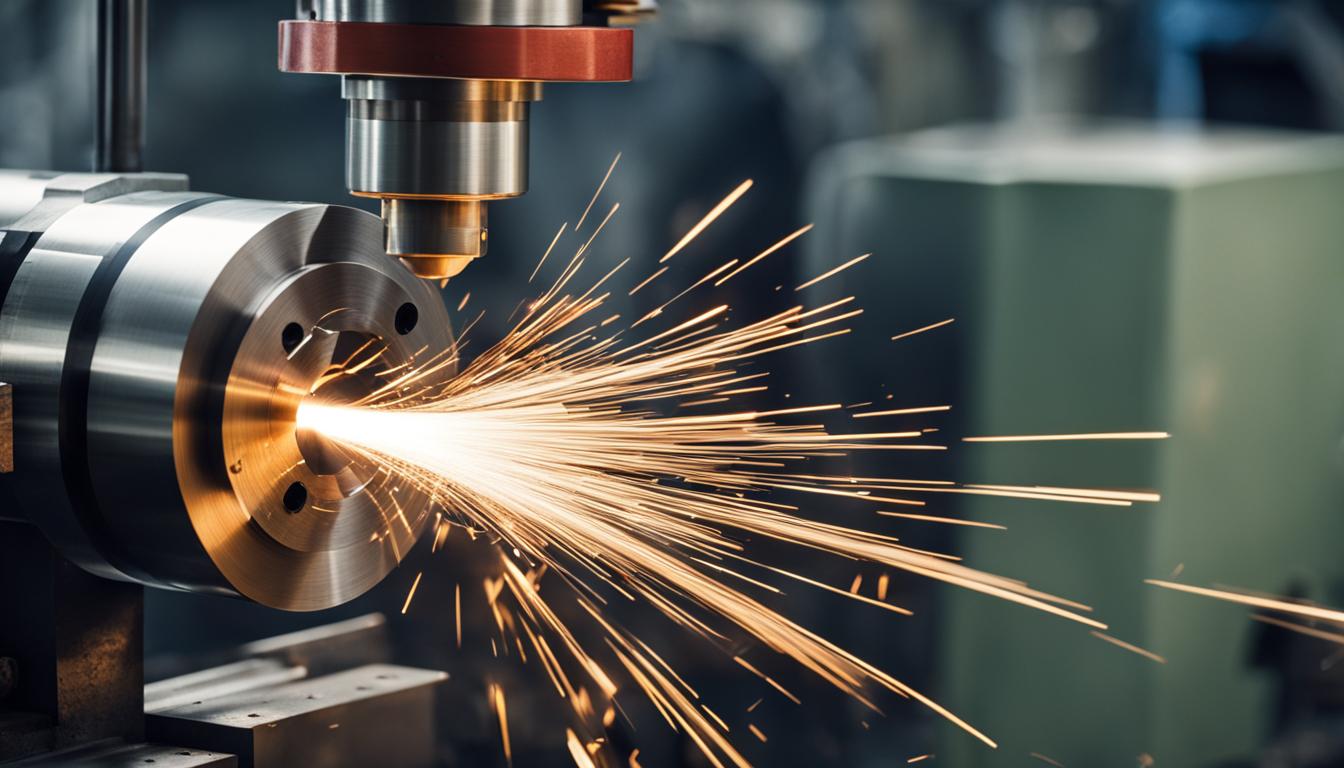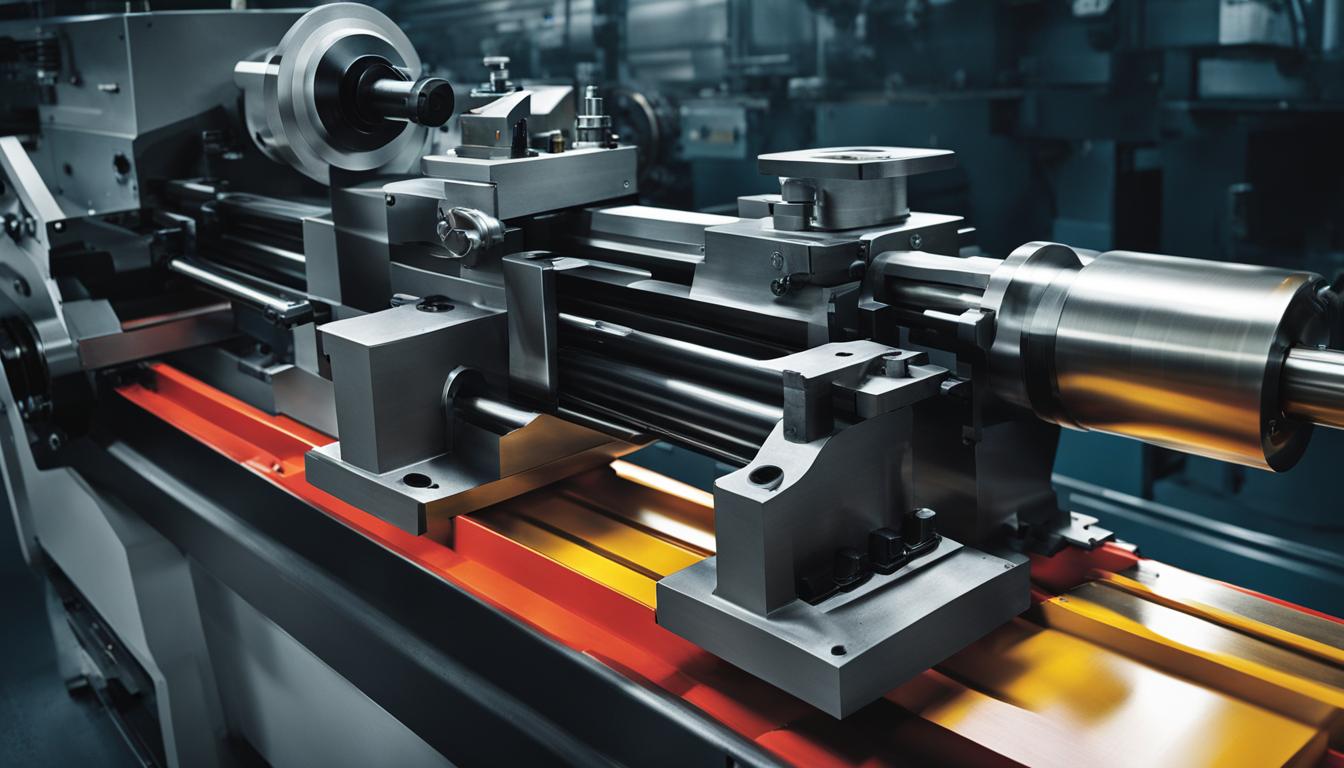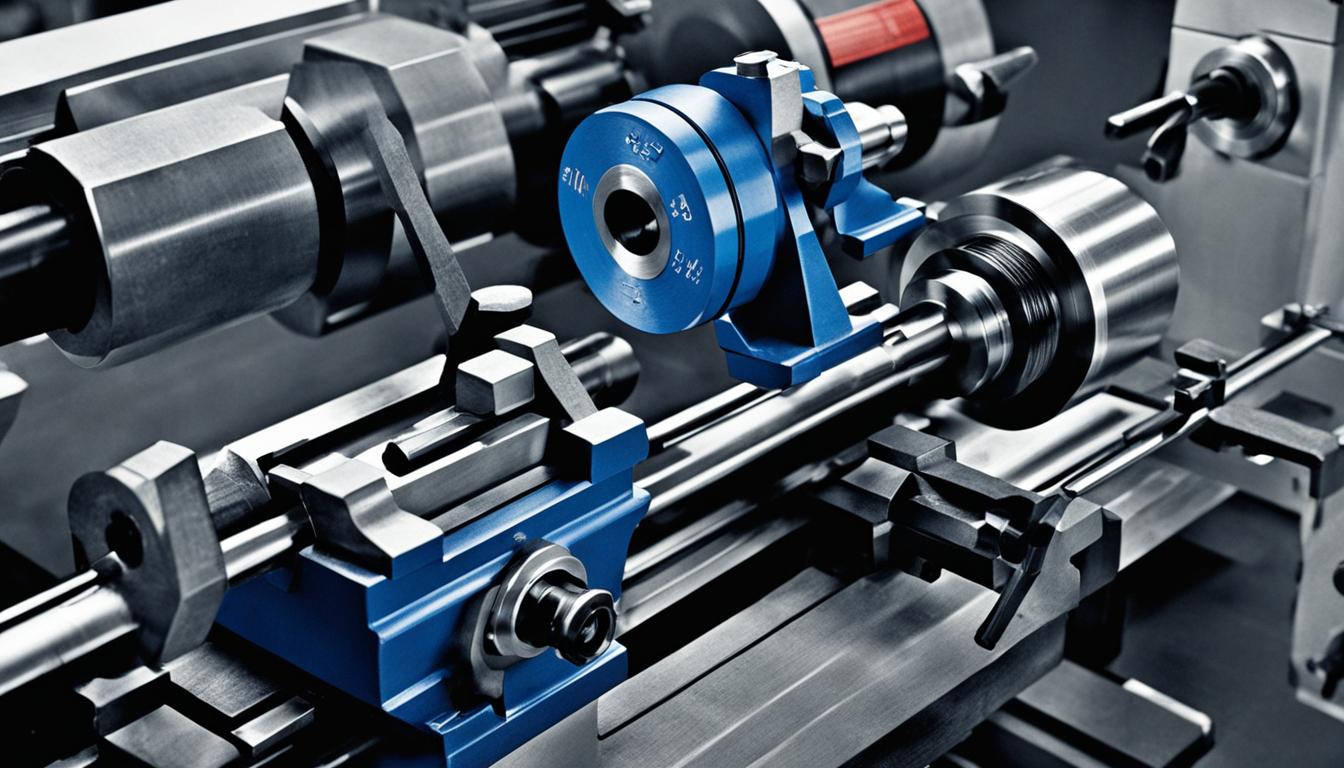A lathe and a turning machine are often used interchangeably, but there are key differences between the two. While they may look similar, turning machines, also known as CNC turning centers, are an upgrade from traditional lathes. Both machines perform similar tasks, such as spinning material and cutting it away to create a desired shape. However, turning centers offer additional features like automated tool changing, live rotating tools, efficient chip removal, and the ability to complete multiple components in one setup. CNC lathes, on the other hand, are standard lathes with the addition of computer numerical control, allowing for repetitive and multi-axis control for creating angles and radii on turned parts.
Key Takeaways
- Turning machines, or CNC turning centers, are an upgrade from traditional lathes.
- Turning centers offer additional features like automated tool changing, live rotating tools, efficient chip removal, and the ability to complete multiple components in one setup.
- CNC lathes are standard lathes with the addition of computer numerical control for repetitive and multi-axis control.
- The choice between a lathe and a turning machine depends on factors like production rate, complexity of the project, and the need for additional features.
- Understanding the differences between a lathe and a turning machine is essential for selecting the right machine for your specific requirements.
What is a CNC Lathe Machine?
A CNC lathe machine is a versatile tool used in the manufacturing industry for shaping and machining various materials. It is a modernized version of the traditional lathe, incorporating computer numerical control (CNC) technology for enhanced precision and efficiency.
The CNC lathe machine offers several features and benefits that make it a valuable asset in machining operations:
- Computer Numerical Control: With CNC technology, the lathe machine is controlled by a computer program. This allows for precise and automated operation, ensuring consistent results and reducing the need for manual intervention.
- Multi-Axis Control: CNC lathes can perform machining tasks in multiple axes. This capability enables the creation of complex shapes, angles, and radii on turned parts with ease.
- Flat Bed Design: Most CNC lathes feature a flat bed design, providing a stable and rigid platform for machining operations. The bed typically consists of a gear-driven headstock at one end and an adjustable tailstock at the other.
- Tool Carriage: The tool carriage rides on the bed of the lathe machine and carries the cutting tool. It is mounted on top of a cross slide, allowing for precise movement and control during machining tasks.
- Replacement of Manual Lathes: CNC lathes are replacing older manual lathes in many manufacturing facilities. The automation and advanced features of CNC lathes improve productivity and reduce human error.
CNC lathes find applications in various industries, including aerospace, automotive, medical, and more. They are suitable for toolrooms, designers, and lower production requirements. CNC lathe machines can be programmed with coded files, which are uploaded to the CNC control. Alternatively, they can be positioned manually, with each position “remembered” for the controller to return to later in a sequence.
While CNC lathes offer advanced control and automation, it’s worth noting that they are not typically equipped with an automated tool changer or easily automated for material handling. These limitations are important considerations when selecting a lathe machine for specific machining needs.
What is a Turning Center Machine?
A turning center machine, also known as a CNC turning center, is an advanced version of a lathe. Unlike traditional lathes, turning centers have a slant bed design, where the bed and way system are at an angle to the center of part rotation. This unique design allows for better control of chip flow and easy chip removal.
Turning centers are typically housed within a full machine enclosure to protect the operator and surrounding area from chips and coolant, ensuring a safe working environment. These machines have higher RPM capabilities, enabling high material removal rates for increased productivity.
One of the key features of a turning center is the ability to fit live tools. Live tools are attachments that can perform milling, drilling, and tapping tasks across the turned profile, allowing for the creation of complex and precise components.
Another important feature of turning centers is their ability to automatically change tools within a programmed cycle. This feature enhances efficiency and reduces downtime, making the machining process more streamlined and productive.
Turning centers can also be equipped with additional features like Y-axis movement and sub spindles, further increasing their versatility. The Y-axis movement enables machining operations in multiple directions, providing flexibility in component design. Sub spindles allow for secondary operations on the reverse side of the turned parts, eliminating the need for manual intervention and reducing production time.

There are two main types of turning centers: horizontal and vertical. Horizontal turning centers are the most common and have a horizontally oriented spindle. They are versatile and suitable for a wide range of applications.
On the other hand, vertical turning centers have a vertical spindle and are useful for larger pieces at lower RPMs or small parts that require a second turning operation. The vertical orientation of the spindle allows for efficient chip evacuation, ensuring smooth and uninterrupted machining.
| Turning Center Type | Spindle Orientation | Key Characteristics |
|---|---|---|
| Horizontal Turning Center | Horizontal | Versatile, suitable for various applications |
| Vertical Turning Center | Vertical | Ideal for larger pieces and small parts with a second turning operation |
Overall, turning centers offer advanced features that enhance productivity, precision, and flexibility in machining operations. They are well-suited for complex component manufacturing and are widely used across industries such as automotive, aerospace, and energy.
CNC Turning Center or CNC Lathe: Which is Right for Your Project?
The choice between a CNC turning center and a CNC lathe depends on the production rate and complexity of the project.
CNC lathes are better suited for short production runs, simple parts, and quick repairs. They can be easily set up and operated manually or with CNC programs. These machines provide reliable and efficient performance for basic turning operations.
On the other hand, CNC turning centers are ideal for production and material removal. They are capable of performing more automated tasks at a higher rate than CNC lathes. Turning centers offer additional features like milling capability, multiple-axis capabilities (such as Y-axis and sub-spindle), and automated tool changing.
These advanced machines provide enhanced versatility and efficiency for complex production requirements. They are well-suited for projects that require multiple operations, such as turning, milling, drilling, and tapping, all in one setup.
If a machine is needed for multiple tasks and flexibility is important, a CNC turning center with additional features is the better choice. It offers the ability to perform a wide range of operations and produce components with higher precision and productivity.
To summarize, CNC lathes are suitable for shorter production runs and simpler parts, while CNC turning centers are better suited for more complex production requirements with additional features and automation capabilities. The choice between the two depends on the specific needs of the project.
Turning Center Basics
Turning centers are advanced CNC machines that offer increased flexibility and efficiency in machining operations. They can perform various operations, including turning, milling, drilling, and tapping, making them versatile tools for a wide range of applications. Turning centers are equipped with a spindle that holds the workpiece securely in place, allowing for precise machining. The carriage supports the cutting tool, which can perform more complex operations compared to traditional lathes.
One of the key advantages of turning centers is their ability to cut around corners, drill, bore, and ream with ease. This makes them suitable for creating intricate shapes and achieving precise dimensions. Turning centers also feature knurling capabilities, which allow for the creation of a grip on tools. Additionally, they can perform operations like cutting tapers, threading, and facing, ensuring clean edges and accurate length trimming.
The CNC control systems integrated into turning centers enable precise movement and operation. These control systems provide the necessary instructions for the cutting tool, resulting in accurate and repeatable machining. With the ability to automate processes, turning centers offer increased productivity and consistency in manufacturing operations.
Overall, turning centers are essential machines in the manufacturing industry, delivering advanced capabilities and enhanced efficiency for a wide range of machining operations.
| Features | Description |
|---|---|
| Turning | Performs rotational cutting operations on the workpiece. |
| Milling | Enables the cutting tool to move in multiple directions to create complex shapes and contours. |
| Drilling | Creates holes in the workpiece with precision and accuracy. |
| Tapping | Creates internal threads in the workpiece for fastening applications. |
| Knurling | Forms a cross-hatched pattern on the workpiece, creating a better grip for tools. |
| Cutting Tapers | Produces tapered surfaces on the workpiece for specialized applications. |
| Threading | Creates external threads on the workpiece for fastening applications. |
| Facing | Creates clean, flat surfaces on the workpiece. |
Horizontal Machining Center Applications
Horizontal machining centers, the most common type of turning centers, have a wide range of applications in various industries. With their automatic tool changes, these centers eliminate setup and machining time, making them ideal for industries that require efficient and high-speed machining. Their versatility allows them to handle different materials and sizes, making them suitable for use in automotive, aerospace, construction, and energy industries. The ability to switch tools in turning centers increases productivity, reduces labor costs, and enables continuous cutting as long as material is fed into the machine.

Horizontal turning centers are widely used in different industries for a variety of applications. Here are some key examples:
- Automotive industry: Horizontal turning centers are used for manufacturing components such as engine blocks, crankshafts, and camshafts. They can efficiently handle large volumes of workpieces and perform precise machining operations.
- Aerospace industry: Turning centers are utilized in aerospace manufacturing to create critical components like turbine blades and aircraft landing gear. Their ability to handle complex shapes and materials makes them indispensable in this industry.
- Construction industry: Horizontal turning centers are employed in the construction industry to produce parts for heavy equipment, such as excavator buckets, crane components, and hydraulic cylinders.
- Energy industry: Turning centers play a crucial role in the energy sector for manufacturing components used in power generation equipment, such as turbine rotors, generator shafts, and gearboxes. They ensure precise machining for optimal performance and reliability.
The table below summarizes the applications of horizontal turning centers in different industries:
| Industry | Applications |
|---|---|
| Automotive | Engine blocks, crankshafts, camshafts |
| Aerospace | Turbine blades, landing gear components |
| Construction | Excavator buckets, crane components, hydraulic cylinders |
| Energy | Turbine rotors, generator shafts, gearboxes |
Choosing Between Horizontal and Vertical Turning Centers
The choice between a horizontal turning center and a vertical turning center depends on several factors.
Horizontal Turning Center: Horizontal turning centers have a horizontally oriented spindle and tools that approach the workpiece from above. They are suitable for cutting across the workpiece using gravity to pull away the chips. These turning centers are commonly used in industries such as automotive, aerospace, construction, and energy.
Vertical Turning Center: On the other hand, vertical turning centers have a vertical spindle and tools that approach the workpiece from the side. They are ideal for handling larger pieces at lower RPMs or small parts that require a second turning operation. These turning centers are widely used in industries where vertical operations and second turning operations are necessary.
The orientation of the spindle has a significant impact on chip clearance and surface finish. Gravity helps to clear chips in horizontal turning centers, making them more suitable for cutting across the workpiece. However, vertical turning centers may face challenges in chip removal, especially if the top has a bowl-shaped indentation.
The choice between a horizontal turning center and a vertical turning center depends on the specific application and the requirements of the project. Industry needs, workpiece size, and the type of operations required are important factors to consider when making a decision.
Comparison of Horizontal and Vertical Turning Centers:
| Factors | Horizontal Turning Center | Vertical Turning Center |
|---|---|---|
| Spindle Orientation | Horizontal | Vertical |
| Tool Approach | From Above | From the Side |
| Chip Clearance | Gravity Clears Chips | May Face Challenges in Chip Removal |
| Ideal for | Cutting Across the Workpiece | Larger Pieces and Second Turning Operations |
Image: Visual representation of a horizontal turning center (left) and a vertical turning center (right).
Turning Center and Lathe Market Outlook
The turning center and lathe markets are witnessing significant growth in response to the rising demand for high-quality and precise components across various industries. Both the turning center market and the lathe market have experienced substantial expansion, driven by factors such as increased industrial activities, higher levels of automation, integration of advanced technologies, and the need for precision and accuracy.
The global market for CNC machines, including turning centers, is expected to grow at a compound annual growth rate (CAGR) of 8.7% and reach a valuation of $185.4 billion by 2032. This growth can be attributed to the advantages offered by turning centers in terms of enhanced automation, improved productivity, and efficient chip removal. The turning center market has seen steady growth due to its ability to meet the demands of diverse industries.
Similarly, the global market for lathes is projected to grow at a CAGR of 5% and reach a value of $32.7 billion by 2028. The increasing demand for lathes in manufacturing industries, the integration of CNC technology, and the need for flexibility are some of the key factors driving the growth of the lathe market. Lathes continue to be an integral part of machining processes, providing precision and versatility for a wide range of applications.
These market trends indicate the growing importance and demand for both turning centers and lathes in the manufacturing industry. As industries continue to evolve and demand better quality components, the turning center market and the lathe market are expected to witness sustained growth in the coming years.
Key Types of Turning Centers and Lathes
When it comes to turning centers and lathes, there are several types available on the market, each with its own unique features and capabilities. Let’s explore the main categories of turning centers and lathes:
Turning Centers:
Turning centers can be classified into two main types: horizontal turning centers and vertical turning centers. Here’s a closer look at each:
| Type of Turning Center | Description |
|---|---|
| Horizontal Turning Centers | These are the most common types of turning centers. They feature a horizontally oriented spindle, offering stability, rigidity, and versatility in machining operations. |
| Vertical Turning Centers | Vertical turning centers have a vertical spindle and are suitable for larger workpieces and small parts that require a second turning operation. |
Lathes:
Lathes also come in various types, each designed to meet different machining needs. Let’s take a look:
| Type of Lathe | Description |
|---|---|
| CNC Lathes | CNC lathes are upgraded with computer numerical control, offering automation and precision in machining operations. |
| Bench Lathes | Bench lathes are compact and portable machines that are suitable for smaller workpieces and workshops with limited space. |
| Automatic Lathes | Automatic lathes are highly automated machines used for high-speed production, offering efficiency and productivity. |
| Capstan/Turret Lathes | Capstan/turret lathes feature a turret or tooling station, allowing for quick tool changes and high production rates. |
Choosing the right type of turning center or lathe depends on the specific requirements of your project or application. Consider factors such as the size of the workpiece, the complexity of the machining tasks, and the desired level of automation.
By understanding the different types of turning centers and lathes available, you can make an informed decision and select the machine that best suits your needs.
Conclusion
In conclusion, the key differences between a lathe and a turning machine, or CNC turning center, lie in their features and capabilities. Turning centers, with their automated tool changing, live rotating tools, efficient chip removal, and ability to complete multiple components in one setup, offer enhanced functionality compared to traditional CNC lathes. On the other hand, CNC lathes, while lacking some of the advanced features of turning centers, provide the benefits of computer numerical control for repetitive and multi-axis control.
The choice between a CNC turning center and a CNC lathe ultimately depends on the specific requirements of the project. Factors such as production rate, complexity of the project, and the need for additional features like milling and sub spindles should be considered. Turning centers are ideal for high-volume production and tasks that require diverse machining capabilities, such as milling and drilling. CNC lathes, on the other hand, are suitable for smaller production runs and simpler parts.
In the continuously evolving manufacturing industry, both turning centers and CNC lathes have their own advantages and applications. It is important for businesses to carefully assess their project requirements and consider the advantages offered by each machine type. By selecting the most appropriate machine, manufacturers can optimize their production processes, improve efficiency, and achieve the desired levels of precision and quality.
